I bet you read that title and thought, “meh, this doesn’t pertain to me as a search marketer…. Give me the nitty-gritty tactics and strategies I need to do my job.”
But if you’re thinking that, I’d say you’re wrong.
Privacy and data have everything to do with the long term strategy not only for search but digital marketing and the tactics used to both find and engage customers.
Personalization when thoughtfully done and well-executed can and will help improve your search performance.
With everything going on in the world around us – yes, we’re still in unprecedented times and the only thing certain for the future is uncertainty – there has been an interesting uncurrent happening with a focus on privacy and data.
You may have skimmed past an article about identifier for advertising (IDFA) being crippled by the iOS14 update coming this fall or that Chrome is planning to end support for third-party tracking cookies.
Did that make you shiver?
Did it strike fear in your heart?
Maybe, or maybe not.
But just maybe you see how this undercurrent can impact search and our marketing strategies.
These trends and seeing them coming is what led me to conduct our 2020 Consumer Privacy study on behalf of Microsoft Advertising in conjunction with Jeremy Hull and Misty Locke of iProspect.
We released the findings in the whitepaper, In Brands We Trust: The Intersection of Privacy and Trust in the Age of the Empowered Consumer.
We surveyed 24,000 customers across 16 countries (on every continent outside of Antarctica) to understand consumers’ views on privacy, data, personalization, and trust.
For me, the biggest takeaway was the gaps between consumer expectations and what is being delivered with respect to personalization.
Data: The Paradox of Privacy & Personalization
Data is the key obstacle of personalization.
According to Gartner’s study, 27% of marketers believed that data was the key obstacle to personalization.
Personalization and privacy are symbiotic – they go together like peanut butter, bacon, and jelly.
The paradox is that there is inconsistency with what consumers want (and are expecting) and what we as marketers are delivering.
The research I conducted mirrored the results that Gartner saw.
Consumers are concerned about privacy and data. They are starting from a place of distrust.
They want personalization, but they don’t really know what they want and they can’t really identify personalization if they are given it (or not).
There are huge gaps in consumers’ understanding and expectations and what is being delivered by brands and marketers alike today.
Personalization Is – the Bee’s Knees. Over-Rated. Dying.
In December 2019, Gartner declared that personalization was dying and that 80% of marketers will abandon personalization efforts by 2025.
However, a few days later the Association of National Advertisers declared personalization the marketing word of the year.
There is a sweet juxtaposition about both of these ideas – personalization is what marketers believe will improve the customer experience and thus engagement, but the cost of personalization (technology and time) and not meeting customer expectations is where we’re falling short.
Why are we falling short?
I think it’s because we got in our heads that we needed to do 1:1 personalization. I’m guilty of wanting and coveting doing this.
In all reality, 1:1 personalization is expensive and requires both high-quality data and technology solutions (piping the data, and then creating segments and options) to make it work.
Instead of 1:1 personalization, let’s shift our thinking toward creating audience segments based on data we have.
You can still get down into nitty-gritty with segmentation: one-to-a-few, one-to-many versus one to all.
Then tailor the targeting, messaging, offers, and the experience to the audience segment based on the data that we already have… before we ask for more data.
Based on my research, the largest gap today is that consumers don’t feel like they are getting good value from sharing their personal data.
Only 15% of respondents felt like they are getting “good value” from the data they are sharing.
Additionally, two-thirds of consumers had little to no understanding of how companies are using their personal data.
Wow.
That’s the heart of the issue.
The true value of data lies in the exchange.
What does the consumer give up, and what do they receive?
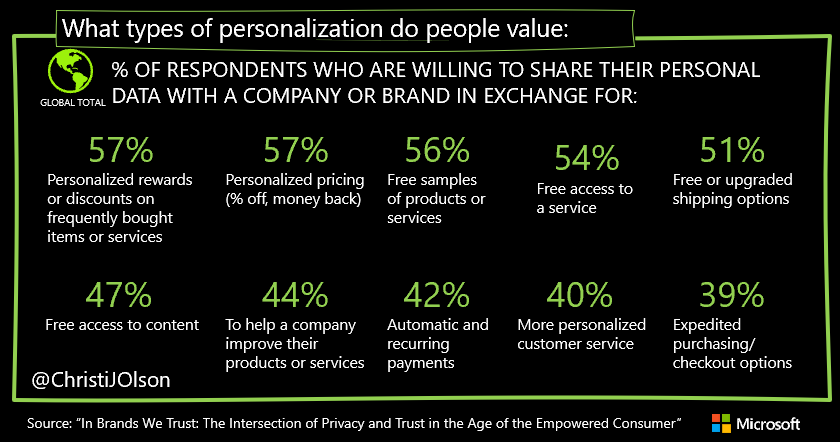
Survey respondents were provided with a list of 20+ ways data can be used for personalization.
We then asked a series of questions such as:
- Would you be willing to share basic personal information in exchange for the following […]?
- What types of personalization are you experiencing today?
- What would you want?
Overall, there wasn’t a clear winner that stood head and shoulders above the rest.
The two most selected items that people would be willing to share information with both involved personalizations of rewards, discounts, and pricing, but even then only 57% of total respondents selected those options.
There wasn’t a clear winner with what respondents valued in getting from sharing their data or what types of personalization they would want.
There is a gap in the data we are collecting and the experiences we are creating for our customers.
That gap leads to an imbalance in the data exchange. An imbalance in the data exchange breeds distrust.
Distrust leads to losing customers.
If we truly understand our customers and what they value, we should be using that knowledge to create great customer experiences right?
But it’s hard!
And difficult.
And. A. Lot. Of. Work.
Customer Experience Is at the Heart of Privacy & Personalization
Value is the key.
You have to bring value to your customers, to your prospects, to your leads.
Keep that context in mind as you collect, access, and use data.
In our research 91% of respondents were concerned about the amount of data companies can collect about them.
At the same time, 88% have either refused to give or provided false information when they were asked to provide personal info.
You see, privacy isn’t solely a policy, compliance, or legal issue.
Personalization isn’t solely a privacy, data, or trust issue.
They are both consumer experience issues.
The consumer needs to be at the heart of everything we do.
It’s a shift in mindset, from marketer focused to consumer-focused. From selling a widget to solving a problem or providing a solution.
Audience Targeting Allows Personalization in Search
Yeah, yeah, yeah, you say, “But how does privacy, data collection, and personalization pertain to paid search?
(Other than those three words you mentioned earlier: Targeting. Tracking. Attribution)
I’m glad you asked.
In the past, search was focused on keywords and products.
The Account and Campaign structure was based on products or services, and search marketers reached their audiences based on the keywords they selected.
Search has evolved to become audience-centric – moving the core focus from products and keywords to audiences.
Search marketers today can leverage strategies to reach a specific audience – and tailor the message and landing page based on what they know about a specific audience.
Today, we take keywords, add in demographics, connect your data with the power of Microsoft intelligence, and layer in audience targeting to help you pinpoint your target customers.
We can include audiences, exclude audiences, we can create custom combinations of actions or audiences to include or exclude together to reach a very specific niche segment.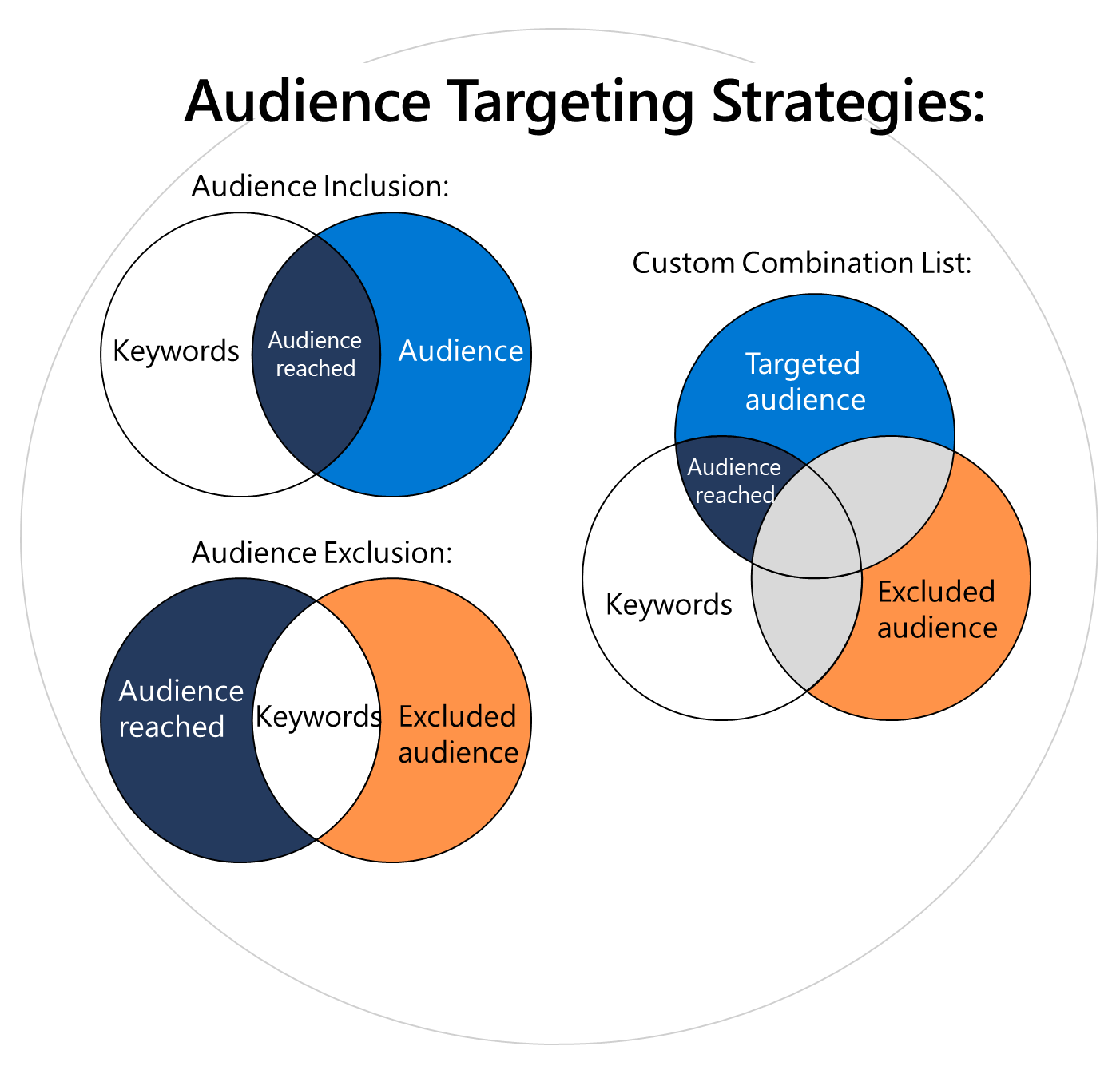
Here Are 7 Things to Consider Around Segmentation for Audience Targeting
1. Know Thy Audience & Create Useful Segmentation & Lists
Remember, you aren’t always your target audience.
If you want to start with the most simplistic audience segmentation, I’d recommend the following two segments: those who know you and those who do not.
Then you start defining and creating more audience segments from there.
- Those who abandon a shopping cart.
- Those who have purchased a specific product.
- Those who are investigating and engaging with a product or service but haven’t bought yet.
- Those who search for organic or environmentally friendly options.
- Those who are price sensitive.
The list goes on and on and on. But remember, just because you can segment, doesn’t mean you need to.
If you aren’t going to adjust the levers.
2. Educate Yourself on the Different Needs & Expectations of Your Audiences
You can adjust your messaging and copy for your most loyal customers – and you’d want it to be different from someone who is just discovering you and learning about your brand, products, and services.
3. Focus on the Words That Your Audience Uses (Not Just the Ones That You Use)
When I worked in the travel space, we often had hoteliers that had ADA accessible rooms available.
They’d often bid on keywords like “accessible hotel rooms” or “wheelchair friendly hotels.”
That’s a great start, but not necessarily how individuals in wheelchairs are searching.
They may be looking for “hotels with roll-in showers”.
See the keyword gap?
Take [roll-in showers] as a proxy keyword and use it in a keyword discovery tool like Microsoft Advertising Intelligence to discover similar and other keywords that your audience may be using.
This allows you to create a more inclusive keyword set that really engages your target audience.
4. Understand How to Adjust the Available Levers to Meet Your Audience & Their Needs
Audiences can be applied at the Ad Group or Campaign level.
Once an audience is applied, you can adjust your strategy by deciding which features you want to adjust while reaching that audience.
The feature or levers available are:
- Keywords.
- Bid Modifiers (a.k.a., CPC)
- Ad Copy.
- Landing Page.
You can change how you reach your audience by adjusting one or all of these levers.
You can select different keywords to target based on the audience.
You can adjust the bid strategy and optimize it against a different CPA by audience.
You can adjust the ad copy and message for an audience.
And finally, you can target a different or unique landing page for an audience.
5. Recast the Role of Audience Targeting Plays
Incorporate more inclusive keywords, language, and content in addition to personalized campaigns.
6. Document, Document, Document
Why is document on the list?
Because you’ll want to document who your audiences are, the differences in the keywords or the messaging to reach the audience, etc.
While your segmentation strategy may seem really intuitive and direct to you, would your co-workers or boss be able to understand if you wanted to take an extended vacation?
If you document upfront then you have the information they need to understand the who, what, where, why’s, and how you implement your audience strategy.
7. Become a Leader in Audience-Based Search Strategy
But remember, start small (and basic) then test and expand as you gain better understanding and insights into your audience.
The biggest challenge with this strategy is that the audience segmentation and targeting could cause PPC account structures to go crazy.
It has the opportunity to exponentially make accounts larger. That’s not my goal with this strategy.
The goal or idea is to use the data we have to create better and more meaningful experiences with our customers.
Sure you might be using audience targeting from in-market audiences, to RLSA, to custom audience and customer match, maybe even custom combinations.
But are you doing it with the lens of your customer and their needs, or the lens of your marketing goals and marketing needs?
Eeks. I said it.
That can be a problem if you are only focusing on you and not the customer.
Making It Actionable: Audience Segmentation in Action
Okay, now is the time for some fun in moving from a theory or concept into action.
First off, for the sake of brevity, I’m not going to go through every step listed above. Instead, I’m going to simplify it.
At this point, you’ve identified your audience and where they fit in the customer journey, their wants, and their needs.
Here is how you implement that.
Audience Inclusion: Re-Engaging With Consumers Who Have Abandoned Their Shopping Cart, but Are Still Searching
Let’s start with a simple example of re-engaging with consumers who have gone to an ecommerce site, added an item to their shopping cart, and then left without completing the purchase.
This is a fairly common scenario, considering on average retailers may have a 1-10% conversion rate.
This means 90-99% of consumers visit the site and leave without making a purchase.
Cart abandonment doesn’t mean that the user isn’t still interested, especially if that consumer is still searching to compare products, review competitor products, and read reviews.
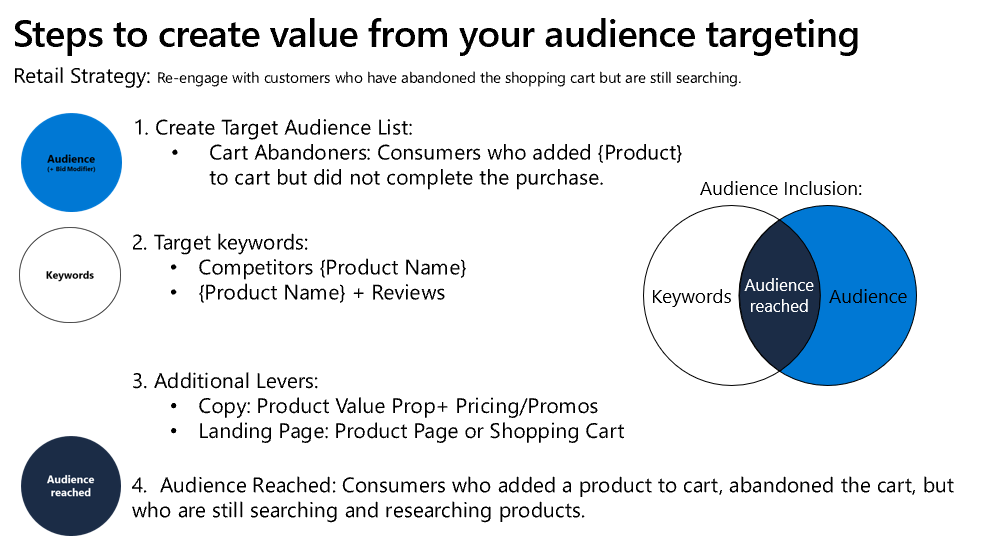
Step 1: The ecommerce site can create an Audience target for specific pages on their website and actions on their website, such as “Add to Cart” button clicks and consumers who do not make it to the “Thank You for Ordering Page.”
These are Cart Abandoners.
They might have many reasons that they abandoned the shopping cart from indecisiveness to daily distractions, accidentally closing a browser window while searching promo codes, or the consumer may be multi-tasking and such as shopping while on a work call.
Whatever the reason, the shopping cart was abandoned.
Step 2: You apply the Audience through Remarketing Lists for Search Ads (RLSA) and apply it to a specific campaign or ad group with a positive bid modifier.
The positive bid modifier means that you are including this audience to see your ads. In this instance, I want to reach cart abandoners who are in the indecisive category.
They added the product to the cart, however, they are still searching and looking at reviews as well as comparing and evaluating my direct competitor’s products.
I would apply this RLSA list to an ad group with keywords related to the competitor’s name, competitor’s product name, and my product name plus terms like review, reviews, and comparison.
Step 3: Here, you evaluate which of the Audience levers to use. The levers you have are Bid Modifier, Keywords, Ad Copy, and Landing Page.
Each Ad Group can use any combination of the levers to customize how you engage with the Audience.
Here I would update the ad copy to highlight the value proposition of the product, especially as compared to a competitor’s product, and if I were hoping to win the sale based on the price I would also include any pricing or promotions.
For the Landing Page, if you have content with reviews and product comparisons, I would it against both the shopping cart with the product added to the cart versus the standard product page to see if it improves conversions.
Step 4: Finally, by applying all of these together, you have the ability to reach an audience of consumers who abandoned the shopping cart but are still evaluating their options.
Audience Exclusion: Focusing Your Branded Search Campaigns on New Consumers (Or Those Who Haven’t Recently Purchased, Signed Into Your Website, or Are Already Members of Your Loyalty Program)
In this next scenario, let’s explore how audiences can be used to reach net-new consumers or consumers who haven’t engaged with your website during a specific period of time but are searching for your brand or your products directly.
This strategy can be useful if you are trying to grow your business by reaching net new consumers.
It can also help reduce your CPA for branded keywords because you are choosing to exclude an audience of those who have engaged with you in the past.
I may choose to implement this strategy if I assign a different value for acquiring a new customer versus engaging an existing customer.
This can allow you to change your bid strategy to reach net-new consumers.
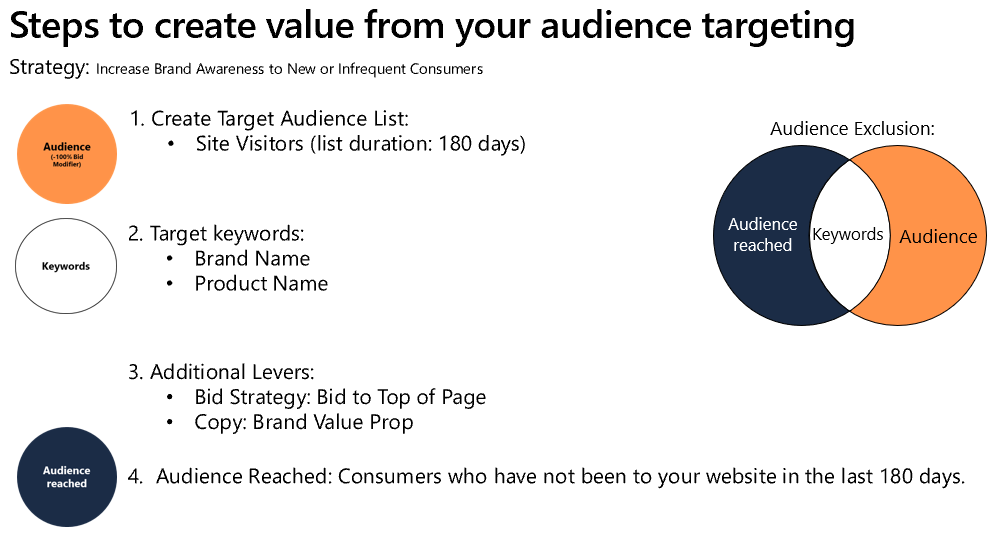
Step 1: Create an audience target for users who have visited your domain.
In this scenario, we are choosing 180 days or approximately 6 months for the list duration, however, you can choose a shorter or longer time frame.
Step 2: You apply the audience through Remarketing Lists for Search Ads (RLSA) against a specific campaign or ad group with a -100% bid modifier.
A -100% bid modifier excludes an audience from seeing an ad.
Step 3: You evaluate which of the Audience levers to use.
The levers you have are Bid Modifier, Keywords, Ad Copy, and Landing Page.
Each Ad Group can use any combination of the levers to customize how you engage with the Audience. Here I would update the ad copy to highlight the brand and products.
I would also adjust my bid strategy to appear toward the top of the page to increase visibility and awareness.
Step 4: By applying all of these together, you have the ability to reach an audience of searchers who haven’t been to your website.
Custom Combinations: Retaining Subscription-Based Purchasers Whose Subscription Is About to Expire (And Get in Front of Them If They Are Searching for Your Direct Customers!)
In this scenario, we are combing together the previous examples showing how you can include some audiences and exclude others in order to be more targeted with your paid search advertising.
Using both inclusion and exclusion can give the ability to reach very specific segments of customers based on what they are searching for and the message that you include.
This strategy is more advanced and requires you to think through:
- Audience segments.
- Their needs.
- How users engage with a brand and website.
- How you can alter either the keywords, the messaging or the bid strategy to reach that set of consumers.
Remember when I said, “Document, Document Document.” This scenario should help you understand why!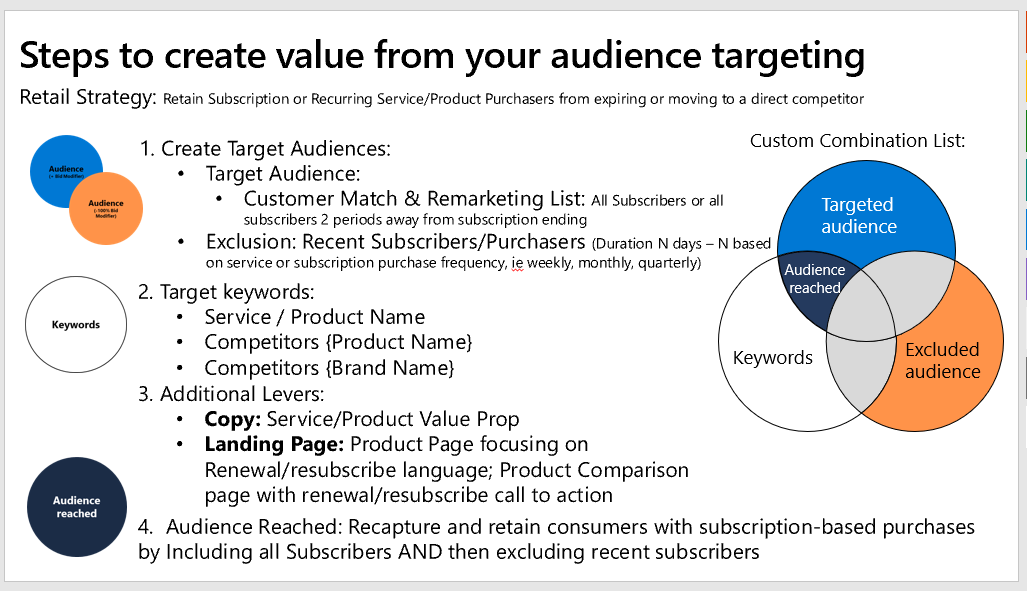
Step 1: There are a few different ways you can create this audience target for exclusion.
If you have a loyalty program, you could use customer match, to create a list of Loyalty Program members or individuals who have recently purchased a product.
If your website has a logged-in state, you could also create an RLSA list of users who have successfully logged into their account.
Step 2: You apply the audience through Remarketing Lists for Search Ads (RLSA) against a specific campaign or ad group with a -100% bid modifier.
A -100% bid modifier excludes an audience from seeing an ad.
In this scenario, I would add audience exclusion to brand keywords, my URL, and any ad groups around my loyalty and rewards program names.
Step 3: You evaluate which of the Audience levers to use. The levers you have are Bid Modifier, Keywords, Ad Copy, and Landing Page.
Each Ad Group can use any combination of the levers to customize how you engage with the Audience.
Here I would update the ad copy to highlight your brand and the value proposition of your brand.
You may also consider adjusting the bid strategy to appear toward the top of the page to increase visibility and awareness.
Step 4: By applying all of these together, you have the ability to exclude your most loyal customers from engaging with your paid advertisements.
This strategy, however, could be risky because you are excluding individuals from seeing your ads.
This strategy is not recommended if your website is not ranking well (near the top of the first page) within the organic search results.
Privacy, Personalization & PPC Do Come Together Flawlessly
The power of audiences is to leverage the data we have, to create and tailor the customer experience.
That is how privacy (collecting and using data), personalization, and PPC come together flawlessly.
Let me hear from you! How do you plan on using segmentation and audience targeting?
More Resources:
- Paid Media & Privacy: What’s Changing & What It Means for Marketers
- PPC Today – Letting Go of What We Were Taught
- How to Leverage First-Party Data to Boost PPC Performance
Image Credits
In-Post Images: Microsoft





